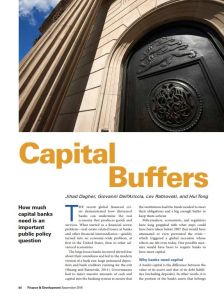Join getAbstract to access the summary!

Join getAbstract to access the summary!
Jihad Dagher, Giovanni Dell’Ariccia, Lev Ratnovski and Hui Tong
Capital Buffers
How much capital banks need is an important public policy question.
Finance & Development Magazine, 2016
What's inside?
Can there be too much of a good thing? When it comes to bank capital requirements, it seems so.
Recommendation
It seems there can be too much of a good thing. After the global financial crisis, policy makers speculated whether they could have mandated a specific level of capital for banks that would have mitigated the crisis’s impact. Economists Jihad Dagher, Giovanni Dell’Ariccia, Lev Ratnovski and Hui Tong find that a higher capital requirement adds critical value up to a certain point, with diminishing returns beyond that. getAbstract suggests this succinct but informative article to regulators and bank executives still wrestling with how to ensure a safe financial system.
Summary
About the Authors
Jihad Dagher et al. are economists with the International Monetary Fund’s research department.


















Comment on this summary